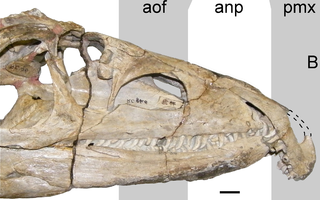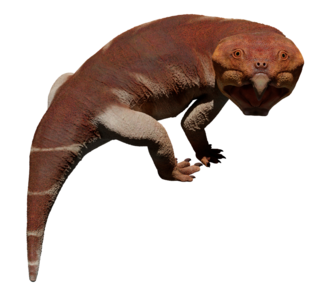
Rhynchosaurs are a group of extinct herbivorous Triassic archosauromorph reptiles, belonging to the order Rhynchosauria. Members of the group are distinguished by their triangular skulls and elongated, beak like premaxillary bones. Rhynchosaurs first appeared in the Early Triassic, reaching their broadest abundance and a global distribution during the Carnian stage of the Late Triassic.

Hyperodapedon is an extinct genus of rhynchosaur reptiles which lived during Late Triassic period. Like other rhynchosaurs, it was an heavily built archosauromorph, distantly related to archosaurs such as crocodilians and dinosaurs. Hyperodapedon in particular was part of the subfamily Hyperodapedontinae, a specialized rhynchosaurian subgroup with broad skulls, beaked snouts, and crushing tooth plates on the roof of the mouth.

Proterosuchus is an extinct genus of archosauriform reptiles that lived during the Early Triassic. It contains three valid species: the type species P. fergusi and the referred species P. alexanderi and P. goweri. All three species lived in what is now South Africa. The genus was named in 1903 by the South African paleontologist Robert Broom. The genus Chasmatosaurus is a junior synonym of Proterosuchus.

The Cynognathus Assemblage Zone is a tetrapod biozone utilized in the Karoo Basin of South Africa. It is equivalent to the Burgersdorp Formation, the youngest lithostratigraphic formation in the Beaufort Group, which is part of the fossiliferous and geologically important Karoo Supergroup. The Cynognathus Assemblage Zone is the youngest of the eight biozones found in the Beaufort Group, and is considered to be late Early Triassic (Olenekian) to early Middle Triassic (Anisian) in age. The name of the biozone refers to Cynognathus crateronotus, a large and carnivorous cynodont therapsid which occurs throughout the entire biozone.
Mesosuchus is an extinct genus of basal Rhynchosaur from early Middle Triassic deposits of Eastern Cape, South Africa. It is known from the holotype SAM 5882, a partial skeleton, and from the paratypes SAM 6046, SAM 6536, SAM 7416 and SAM 7701 from the Aliwal North Euparkeria site. Mesosuchus is quite small, spanning around 30 cm in length. Mesosuchus was discovered and named by David Meredith Seares Watson in 1912.

Rhynchosaurus is a genus of rhynchosaur that lived during the Middle Triassic period. It lived in Europe. It was related to the archosaurs, but not within that group. The type species of Rhynchosaurus is R. articeps. Michael Benton named two additional species, R. spenceri and R. brodiei, but they were subsequently renamed Fodonyx and Langeronyx respectively. Fossils of Rhynchosaurus have been found in the Tarporley Siltstone Formation and possibly the Sherwood Sandstone Group of the United Kingdom.

Isalorhynchus is an extinct genus of hyperodapedontine rhynchosaur from the late Triassic period of Toliara Province, southwestern Madagascar. It is known from the holotype MDE-R18, a nearly complete maxilla and from other specimens from the same locality, Malio River area. It was found in the Makay Formation of the Morondava Basin. It was first named by Eric Buffetaut in 1983 and the type species is Isalorhynchus genovefae. The majority of Isalorhynchus specimens are isolated jaw bones, but two nearly complete skeletons were found in 1998. Langer et al., 2000 concluded that Isalorhynchus is a synonym of Hyperodapedon and referred it to a new species of Hyperodapedon. Whatley, 2005 retained this genus as valid with a description of new materials in her PhD thesis. Montefeltro et al., 2010 and Langer et al., 2010 accepted Isalorhynchus as valid genus.

Bentonyx is an extinct genus of rhynchosaur from the middle Triassic epoch of Devon in England. Its fossil, a well preserved skull, BRSUG 27200, was discovered in Otter Sandstone Formation and was first assigned to Rhynchosaurus spenceri, that is known from 25 specimens. This species was reassigned to its own genus, Fodonyx, that was first described by David W. E. Hone and Michael Benton in 2008. More recently, this skull was reassigned to this genus by Max C. Langer, Felipe C. Montefeltro, David E. Hone, Robin Whatley and Cesar L. Schultz in 2010 and the type species is Bentonyx sidensis.

Fodonyx is an extinct genus of rhynchosaur from the middle Triassic epoch of Devon in England. Its fossils were discovered in Otter Sandstone Formation and were first assigned to Rhynchosaurus spenceri. This species was reassigned to its own genus, Fodonyx the holotype of which is EXEMS 60/1985/292, that described by David W. E. Hone and Michael J. Benton in 2008. In 2010, one skull was reassigned to the new genus Bentonyx. It is distinguished from other rhynchosaurs by a single autapomorphy, the ventral angling of the paraoccipital processes. In all other rhynchosaurs these processes angle dorsally or are horizontal. It is not known if this conferred any advantage to Fodonyx. Fodonyx was between 40 and 50 cm long.
Teyumbaita is an extinct genus of hyperodapedontine rhynchosaur from the Upper Triassic of southern Brazil. Its fossils were recovered from the early Norian-age Caturrita Formation, one of several fossiliferous formations exposed at Paleorrota Geopark in the state of Rio Grande do Sul. Teyumbaita is likely the youngest valid genus of rhynchosaur, as other members of the group likely died out before the start of the Norian.

Stenaulorhynchus is an extinct genus of hyperodapedontid rhynchosaur known from the Middle Triassic deposits of Tanganyika Territory, Tanzania. It was found in the Lifua Member of the Manda Formation in the Karoo Supergroup. It was named and first described by Sidney Henry Haughton in 1932. The type species is Stenaulorhynchus stockleyi, a beaked herbivore measuring 1–6 meters in length.
Supradapedon is an extinct genus of hyperodapedontine rhynchosaur from mid-late Triassic deposits of Tanganyika Territory, Tanzania. It is known from the holotype SAM-11704. The holotype and only specimen of Supradapedon was first assigned to a species of Scaphonyx, Scaphonyx stockleyi. This species was reassigned to its own genus by Sankar Chatterjee in 1980 and the type species is Supradapedon stockleyi. One study, Langer et al. (2000), concluded that Supradapedon is a synonym of Hyperodapedon and referred it to Hyperodapedon sp. However, the provisional validity of this genus has been commonly accepted since.

Hyperodapedontinae is a subfamily of rhynchosaurs within the family Rhynchosauridae. Fossils have been found from Argentina, Brazil, Canada, India, Madagascar, Scotland, Tanzania, United States and Zimbabwe.
Otischalkia is an extinct genus of archosauromoph from late Triassic deposits of Howard County, Texas, US It is known from the holotype TMM 31025-263, left humerus and from the referred specimens TMM 31025-262, TMM 31025-266, TMM 31025-264, TMM 31185-92 and TMM 31185-93. It was found in the Lower Dockum Group near the abandoned settlement of Otis Chalk. It was first named by Adrian P. Hunt and Spencer G. Lucas in 1991 and the type species is Otischalkia elderae.
Mesodapedon is an extinct genus of hyperodapedontid rhynchosaur from middle Triassic deposits of India. It is known from the holotype ISIR-300 and from the paratype ISIR-301 from the Yerrapalli Formation. It was first named by Sankar Chatterjee in 1980 and the type species is Mesodapedon kuttyi. It is extremely closely related to the Tanzanian Stenaulorhynchus and even was considered to be its synonym.

Prolacerta is a genus of archosauromorph from the lower Triassic of South Africa and Antarctica. The only known species is Prolacerta broomi. The generic name Prolacerta is derived from Latin meaning “before lizard” and its species name broomi is in commemoration of the famous paleontologist Robert Broom, who discovered and studied many of the fossils found in rocks of the Karoo Supergroup. When first discovered, Prolacerta was considered to be ancestral to modern lizards, scientifically known as lacertilians. However, a study by Gow (1975) instead found that it shared more similarities with the lineage that would lead to archosaurs such as crocodilians and dinosaurs. Prolacerta is considered by modern paleontologists to be among the closest relatives of the Archosauriformes.

Epipophyses are bony projections of the cervical vertebrae found in archosauromorphs, particularly dinosaurs. These paired processes sit above the postzygapophyses on the rear of the vertebral neural arch. Their morphology is variable and ranges from small, simple, hill-like elevations to large, complex, winglike projections. Epipophyses provided large attachment areas for several neck muscles; large epipophyses are therefore indicative of a strong neck musculature.

Noteosuchus is an extinct genus of basal rhynchosaur known from the earliest Triassic deposits of Eastern Cape Province, South Africa. It was first named by David Meredith Seares Watson in 1912 and the type species is Eosuchus colletti. The generic name Eosuchus is preoccupied by the generic name of Eosuchus lerichei Dollo, 1907, a gavialoid crocodilian known from northern France. Thus, an alternative generic name, Noteosuchus, was proposed by Robert Broom in 1925. The generic name erected by Broom (1925) is a compound, meaning "Not Eosuchus", while "Eosuchus" is derived from the name of Eos, the goddess of the dawn in Greek mythology, and suchus, Latinized from the Greek souchos, an Egyptian crocodile god, thus meaning "dawn crocodile". The specific name, colletti, honors Mr. Collett for the discovery of the holotype and only known specimen.
Eohyosaurus is an extinct genus of basal rhynchosaur known from the early Middle Triassic Burgersdorp Formation of Free State, South Africa. It contains a single species, Eohyosaurus wolvaardti.
Langeronyx is an extinct genus of basal rhynchosaurid known from the early Middle Triassic Bromsgrove Sandstone Formation of Warwickshire, UK. It contains a single species, Langeronyx brodiei, originally included in the genus Rhynchosaurus. R. brodiei was first described and named by Michael Benton in 1990, but its redescription by Martín D. Ezcurra, Felipe Montefeltro and Richard J. Butler in 2016 recovered it as more closely related to the more advance hyperodapedontine than to the type species of Rhynchosaurus and thus it was moved to its own genus. The generic name Langeronyx honors the Brazilian paleontologist Max Cardoso Langer in recognition of his rhynchosaur research, combined with the Greek onyx (óνυξ) meaning "claw", a common suffix for rhynchosaur genera. L. brodiei is known solely from the holotype, a partial skull divided into the two specimens WARMS G6097/1 and NHMUK PV R8495, housed in the Warwickshire Museum, Warwick and Natural History Museum, London, respectively. Other specimens originally referred to R. brodiei either do not overlap with its type or can be just as likely referred to other basal rhynchosaurids. L. brodiei is one of two basal archosauromorphs known from the Bromsgrove Sandstone Formation, the other being the lesser known Rhombopholis scutulata.













